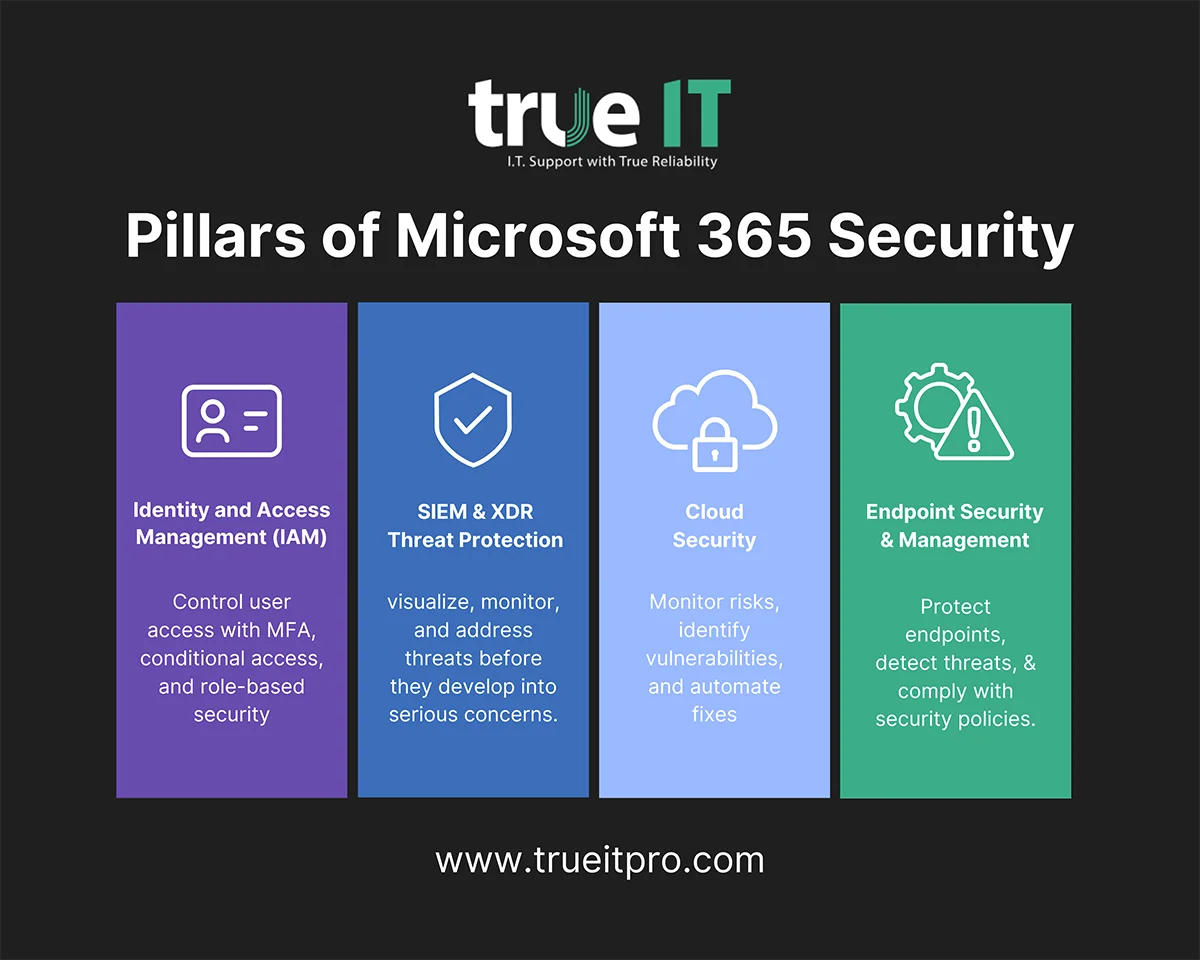
Every day, 345 million people use Microsoft 365 to collaborate, store data, and boost productivity.1 This powerful suite of tools is integral for businesses across the globe—but its widespread adoption has also made it a regular target for cyber-attacks. Phishing, ransomware, and insider threats are just a few risks that can lead to catastrophic breaches and financial loss.
The good news is that Microsoft 365 has many security features and products to protect your business, your team, and your bottom line from devastating cyber threats. With proper configuration and the right strategies, you can reinforce your Microsoft 365 security and greatly minimize risks.
In this comprehensive guide, we explore everything you need to know about Microsoft 365 security, why it matters, and share best practices for keeping your organization secure.
What Is Microsoft 365 Security?

Microsoft 365 is a cloud-based productivity suite best known for tools like Microsoft Word, Excel, PowerPoint, Outlook, and Teams. These applications are a vital part of daily operations for many businesses.
However, its widespread use makes the Microsoft 365 suite a prime target for cyberattacks like phishing, ransomware, and more. Without a proper security strategy, these threats can lead to data exposure, costly downtime, and devastating financial loss for businesses big and small.
Microsoft 365 Security refers to the platforms and measures used to protect your organization’s Microsoft 365 ecosystem from common cyber threats. If your business doesn’t have a Microsoft 365 security strategy, you’re already at risk.
The 4 Pillars of Microsoft 365 Security

Every time you open a Word doc or send an email through Outlook, you’re trusting Microsoft 365 to keep your data safe. Fortunately, Microsoft offers a range of security products that seamlessly integrate with your apps for an extra layer of protection—but understanding what they do and how to use them is key.
Below, we explore the main pillars of Microsoft 365 security and the products designed to enhance each one:
Identity and Access Management (IAM)
Controlling who can access what data is a fundamental part of cybersecurity. Identity and Access Management (IAM) helps protect your Microsoft 365 environments from unauthorized access.
Microsoft’s main IAM product is Microsoft Entra ID. Formerly called Azure Active Directory, this is a cloud-based service that ensures that only the right people can access your company’s data and applications.
Think of it as a security checkpoint that verifies users before they enter. It uses features like single sign-on (SSO), multifactor authentication (MFA), and more to prevent unauthorized access and safeguard your business.
Threat Protection (SIEM & XDR)
Malware, phishing, ransomware, and other common cyber threats can put your business at serious risk—but it’s not enough to simply know what’s out there. To protect your organization’s Microsoft 365 apps from threats, you’ll need to implement these proactive strategies:
- Security information and event management (SIEM): A system that collects and analyzes security data to identify potential threats in real time.
- Extended detection and response (XDR): A comprehensive security solution that automatically detects, investigates, and responds to advanced cyberattacks across multiple data stores, including your network, endpoints, email, cloud apps, server, etc.
Microsoft Sentinel (SIEM) and Microsoft Defender XDR are threat protection platforms that work together under one unified security operations (SecOps) portal. This gives your IT team a way to visualize, monitor, and address threats before they develop into serious concerns.
Cloud Security
When people talk about the cloud, they’re referring to servers that store and send data and software to other computers, over a network. Cloud security protects this data from cyber threats to ensure privacy, compliance, and reliability.
Microsoft 365’s primary product for this pillar is Microsoft Defender for Cloud. This platform seamlessly integrates with your Microsoft 365 ecosystem to boost your security posture and safeguard organizations from cyber threats.
The main functions of Microsoft Defender for Cloud include:
- Security Posture Management: Continuously monitor security risks across cloud environments, identify vulnerabilities, and automate fixes to keep your systems protected.
- Workload Protection: Prevent, detect, and promptly respond to cyber threats across your cloud ecosystem with built-in threat detection and real-time response.
By leveraging Microsoft Defender for Cloud, businesses can work safely from anywhere without worrying about cyber threats and keep daily operations flowing smoothly.
Endpoint Security and Management
An endpoint is any device that connects to your organization’s network—like laptops, desktop computers, mobile devices, and more. Endpoint security is all about protecting these devices from unauthorized access, detecting cyber threats, and complying with security policies. For this pillar, the primary tool is Microsoft Defender for Endpoint.
Some of the key functions and benefits of Microsoft Defender for Endpoint include:
- Outsmart Cyberthreats with AI: Leverage cutting-edge artificial intelligence to automatically detect and respond to threats helping security teams resolve issues faster.
- Global Threat Intelligence: Access to a global network of cyber security experts providing real-time insights into emerging and persistent cyber threats.
- Secure Devices: Safeguard all endpoint devices with next-generation antivirus, threat detection, and automated response capabilities to stop threats before they spread.
Microsoft Defender helps businesses prevent, detect, investigate, and respond to cyber threats, ensuring devices and data stay protected.
Microsoft 356 Security Best Practices for Businesses

While using the right tools and platforms is important for securing your organization’s Microsoft 365 infrastructure, a robust strategy requires more than that. Below are some essential best practices to strengthen Microsoft 365 security for your business:
1. Use Strong Passwords
Of the 600 million identity attacks that happen every day, 99% of them can be attributed to password-based attacks.2 Weak passwords get cracked fast, which is why the Cybersecurity and Infrastructure Security Agency (CISA) has guidelines for creating strong passwords.3
All passwords within your business’s Microsoft 365 infrastructure should be:
- At least 16 characters long
- As random as possible
- Unique to one account (don’t use the same password more than once)
Ensuring all members of your team follow these password guidelines can significantly boost your Microsoft 365 security.
2. Enable Multi-Factor Authentication (MFA)
Multi-factor authentication (MFA) is designed to prevent unauthorized users from accessing your Microsoft 365 accounts. MFA requires users to not only submit a password but also verify their identity in some other way. This often includes answering security questions, entering codes sent through text or email, or using the Microsoft Authenticator smartphone app.
Enabling risk-based MFA throughout your organization’s Microsoft 365 environment challenges users to verify their identity when suspicious activity is detected. This can significantly lower the risk of unauthorized access.
3. Provide Employee Cybersecurity Awareness Training
Cybercriminals are experts at exploiting people–it’s what they do for a living. Providing cybersecurity awareness training empowers your employees with the knowledge they need to identify and prevent online threats. This can involve risks such as avoiding phishing scams, unsafe downloads, connecting to unsecured networks, proper cyber hygiene, and much more.
This not only protects your team from cybercrime but also safeguards the integrity of your entire organization.
4. Regularly Backup Microsoft 365 Data
Whether from accidental deletion or a targeted ransomware attack, without the right security measures in place, your business is at risk of losing vital data. Regularly backing up your Microsoft 365 data ensures you can quickly recover it when necessary.
Some Microsoft 365 data backup best practices include:
- Set up automated backups for Microsoft 365 apps like Exchange, SharePoint, and OneDrive
- Periodically test your backup and recovery process to ensure you can restore data in case of an emergency
- Store backups in a secure location and ensure they’re protected with encryption
5. Keep Up with Microsoft 365 Software Updates
Most software updates fix bugs or vulnerabilities that put you at risk of cyberattacks. Keeping all your Microsoft 365 software updated ensures your organization has access to the latest security patches, which makes it harder for cybercriminals to exploit you.
Some best practices include:
- Automatic updates: Enable automatic updates so you’re always protected with the latest security features.
- Monitor third-party apps: Make sure any third-party apps integrated with your Microsoft 365 software are also updated regularly to minimize vulnerabilities.
- Outsource software maintenance services: Outsourcing software and application support ensures your business’s critical platforms operate efficiently around the clock.
Empower Your Team with Microsoft 365 Managed Services
Microsoft 365 security is an ongoing process that protects your organization’s most critical applications. With the security products and best practices above, your business can reduce risks, protect sensitive data, and maintain a secure digital infrastructure.
As a business owner, you already have enough on your plate. At True IT, it’s our mission to simplify and strengthen your organization’s IT infrastructure with expert managed services. We’ll provide you with the ongoing support you need so you can focus on growing your business.
Ready to make IT stress-free? Contact us online today or call (707)-755-5858 to schedule a FREE consultation with our IT experts.
References
- Microsoft 365 Suite revenue and growth Statistics (2024) – SignHouse. (2024, August 1). SignHouse. https://usesignhouse.com/blog/microsoft-365-suite-stats/
- Microsoft Digital Defense Report 2024. (n.d.). https://www.microsoft.com/en-us/security/security-insider/intelligence-reports/microsoft-digital-defense-report-2024
- Use strong passwords | CISA. (n.d.). Cybersecurity and Infrastructure Security Agency CISA. https://www.cisa.gov/secure-our-world/use-strong-passwords



Comments